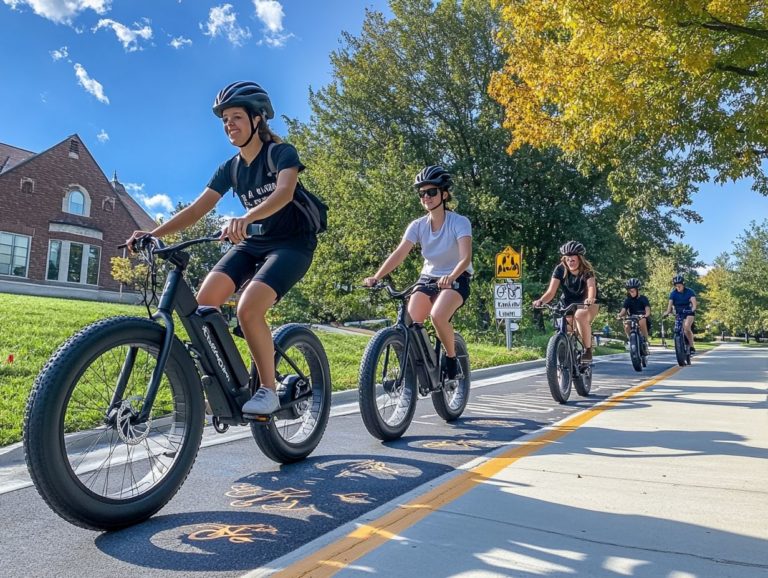The Role of Local Governments in Electric Bike Laws
Electric bikes, or e-bikes, are transforming urban mobility. Understanding the regulations that govern their use is crucial, as this knowledge benefits both riders and cities alike.
This article explores the landscape of electric bike regulations. It covers the different types of e-bikes and the significant role local governments play in shaping the relevant legislation.
It also highlights the environmental impact and health benefits these bikes contribute to communities. Additionally, it examines current e-bike regulations and addresses the challenges and controversies that may arise from their use.
Looking ahead, it provides insights into potential changes in electric bike laws. This information is valuable for every cyclist and policymaker.
Contents
- Key Takeaways:
- Overview of Electric Bike Laws
- The Role of Local Governments
- Benefits of Electric Bikes for Local Communities
- Current Electric Bike Regulations
- Challenges and Controversies
- Future of Electric Bike Laws
- Frequently Asked Questions
- What is the role of local governments in electric bike laws?
- How do local governments regulate electric bikes?
- Do electric bikes have different laws than traditional bikes?
- Why do local governments have a role in regulating electric bikes?
- Can local governments ban the use of electric bikes?
- Is it important for local governments to consult with the community before implementing electric bike laws?
Key Takeaways:
- Local governments play a crucial role in regulating electric bike laws, with the authority to create and enforce regulations that suit their communities.
- Electric bikes offer numerous benefits to local communities, including improved air quality and increased physical activity, making them valuable assets for local governments to promote and support.
- The future of electric bike laws is uncertain, with potential changes and controversies on the horizon as local governments navigate the evolving landscape of e-bike regulations.
Overview of Electric Bike Laws
Electric bikes, or e-bikes, have surged in popularity in recent years. This trend creates an urgent need for clear rules at both the state and federal levels.
These laws cover various topics related to e-bike usage, such as classification, safety requirements, and compliance measures set forth by agencies like the Consumer Product Safety Commission (which ensures that products are safe for consumers).
As urban mobility evolves, understanding the complex landscape of e-bike regulations across various jurisdictions is crucial, whether you re a consumer or a manufacturer.
Understanding Different Types of E-Bikes
E-bikes fall into three primary categories: Class 1, Class 2, and Class 3. Each category is defined by its operational features and speed limitations, making it essential to grasp these distinctions to comply with local ordinances.
Class 1 e-bikes offer pedal-assist functionality, meaning the motor provides a boost only when you’re pedaling, up to a maximum speed of 20 mph. Class 2 e-bikes come equipped with a throttle, allowing you to engage the electric motor without pedaling, also capping at 20 mph. For those seeking speed, Class 3 models offer assistance up to 28 mph. However, be mindful these often require wearing helmets and may have restrictions on where you can ride.
These distinctions shape your riding experience and influence your responsibilities as a rider. Depending on the class of your e-bike, you may need a license or have to follow specific pathways, all crucial for promoting safe and regulated e-bike usage.
The Role of Local Governments
Local governments are instrumental in shaping the realm of electric bike regulations. They influence everything from e-bike infrastructure to public safety measures.
Through establishing municipal laws and ordinances, local authorities ensure that e-bike usage aligns with the unique needs of the community, advancements in transportation technology, and necessary safety protocols.
Their decisions directly affect how residents interact with e-bikes. This influences accessibility, insurance coverage, and the overall community’s engagement in promoting sustainable transportation.
Don t miss out on staying informed about e-bike regulations; understanding these rules is key to enjoying the benefits of electric biking.
Legislative Authority and Decision-Making Process
The legislative authority vested in local governments shapes the decision-making process surrounding e-bike regulations. This ensures that your community’s interests are at the forefront of creating transportation rules.
Local officials engage in public outreach campaigns to gather your input. This fosters a collaborative environment that allows for effective regulation.
This collaborative effort gives the power to municipalities to create regulations that truly reflect the unique needs and values of constituents like you. Take Portland, Oregon, for example extensive community involvement there has resulted in tailored e-bike policies that prioritize safety, accessibility, and environmental considerations.
Local authorities often host community forums and workshops where you can discuss the potential impacts of e-bike usage on traffic patterns and public spaces. This ensures that diverse perspectives are woven into their frameworks.
Ultimately, these regulations aim not only to promote sustainable transportation options but also to enhance the overall quality of urban life. They ensure that every voice in the community, including yours, is heard and valued.
Benefits of Electric Bikes for Local Communities
Electric bikes are changing the game for local communities let’s explore how! They present a wealth of advantages, elevating urban mobility while positively impacting community health and the environment.
By promoting access to e-bikes, cities can effectively reduce traffic congestion, minimize emissions, and cultivate a healthier population through increased physical activity and diverse transportation options.
Cities can also motivate residents to use e-bikes by offering financial incentives, ultimately paving the way for sustainable urban environments.
Environmental and Health Benefits
The environmental impact of electric bikes is truly significant, presenting a cleaner alternative to traditional motor vehicles. By choosing e-bikes, you’re not only cutting down on carbon emissions but also enhancing air quality.
Increased access to e-bikes promotes community health, encouraging both physical activity and efficient transportation options. This ultimately boosts public safety and overall well-being.
Research shows that swapping car trips for e-bike rides can reduce greenhouse gas emissions by about 50% per mile traveled. If you regularly use an e-bike, you re likely to notice an uptick in your physical activity levels, which can lower your risks of heart disease and obesity.
The mental health benefits are just as impressive; cycling outdoors has been linked to reduced anxiety and improved mood. In urban settings, electric bikes could be a game changer, potentially slashing traffic congestion by 15% and paving the way for cleaner, more walkable communities.
Current Electric Bike Regulations
Current electric bike regulations are crafted with your safety in mind. They establish compliance measures and outline essential safety requirements for different e-bike classes, which come with unique rules regarding speed and usage.
These regulations work to minimize e-bike violations while fostering a secure riding environment for everyone. Ultimately, they support the seamless integration of electric bikes into the existing transportation landscape. To ensure you stay within these guidelines, it’s important to learn how to stay compliant with electric bicycle laws, ensuring a safe and enjoyable experience for all riders.
Examples of Local Laws and Regulations
Local laws and regulations surrounding electric bikes, often referred to as e-bikes, vary significantly across different jurisdictions. Each area reflects its unique approach to integrating e-bikes into traffic codes that enhance public safety.
For example, in California, e-bikes fall into three distinct classes, each with specific speed limits and usage guidelines. This classification helps ensure rider accountability and safety. In New York City, riders must wear helmets, and e-bikes must follow certain speed regulations in specified areas, highlighting the community’s focus on protection while promoting eco-friendly transportation. To stay informed about these regulations, consider navigating electric bicycle licensing requirements.
Meanwhile, cities like Denver are exploring e-bike sharing programs. These initiatives foster sustainable commuting and engage local residents in advocating for safe cycling practices. Understanding electric bicycle lane laws and local ordinances exemplifies the balance that many municipalities strive to achieve between embracing new technologies and ensuring safety for all.
Challenges and Controversies
The rise of e-bikes introduces challenges, particularly regarding pedestrian safety and e-bike violations. Conflicting interests among cyclists, pedestrians, and local governments complicate the regulatory landscape.
This dynamic fosters discussions about solutions, as everyone seeks a balance that respects the needs and safety of all involved.
Conflicting Interests and Potential Solutions
Debates over e-bike regulations often focus on pedestrian safety. Various stakeholders advocate for their priorities in urban planning, e-bike classification, and transportation policies. To uncover potential solutions, engage in collaborative efforts to implement Class 1, Class 2, and Class 3 e-bike regulations. Community involvement is essential to ensure e-bike access for all, including local trials in places like Massachusetts and New York.
Ongoing tensions can manifest as designated bike lanes intersecting crowded sidewalks or conflicts at crosswalks. Here, speed and agility are crucial for riders, particularly in congested cities like Chicago and Seattle. Safety concerns arise when riders travel at high speeds, putting themselves and pedestrians at risk.
You can play a pivotal role by advocating for inclusive infrastructure, such as dedicated e-bike lanes separated from pedestrian pathways. Implementing educational programs that promote mutual respect and leveraging technology for real-time traffic management can lead to significant improvements.
Such measures enhance safety and foster a sense of harmony among all urban commuters!
Future of Electric Bike Laws
The future of electric bike laws is approaching substantial evolution. There is an expectation for greater harmonization of regulations, particularly among state regulations. Local governments are likely to adjust their laws in response to advancements in transportation technologies and to comply with Consumer Product Safety Commission standards.
As e-bikes become more popular, governing bodies will likely explore innovative strategies and legislation that impacts e-bikes in states like Alaska and North Dakota. They will tackle unique challenges posed by this emerging mode of transport, including the impact of local laws on electric bike design.
Predictions and Possible Changes
Predictions for the future of electric bike regulations suggest that you can expect increased investment in e-bike infrastructure. Expect better bike lanes in public parks, improved public safety measures, and financial incentives aimed at encouraging greater adoption of e-bikes.
Community engagement strategies to include Department of the Interior and National Park Service are poised to evolve, encouraging open discussions between local governments, e-bike users, and e-bike manufacturers, as well as non-cyclists, especially in areas like Portland and San Francisco. This collaborative approach will create an inclusive atmosphere that values diverse modes of transportation. Such partnerships could lead to tailored regulations that address the unique needs and concerns of your community, informed by state-specific electric bicycle legal frameworks.
As urban areas continue to face challenges like congestion and pollution in Maryland, a focus on seamlessly integrating e-bikes with existing public transit systems may arise. Promoting e-bikes, especially Macfox X1 models, as a practical alternative for both short distances, particularly in 2022 and beyond, and medium-distance travel using government technology and tools like GovPilot could greatly enhance urban mobility, while understanding the future of electric bicycle legislation will be crucial for this integration.
We must continuously monitor and adapt these regulations to keep up with community needs and preferences while addressing any liability issues that may arise.
Frequently Asked Questions
What is the role of local governments in electric bike laws?
The role of local governments in electric bike laws is to create and enforce regulations that govern the use of electric bikes within their jurisdiction.
How do local governments regulate electric bikes?
Local governments can regulate electric bikes by implementing specific rules and restrictions, such as speed limits and where they can be ridden, as well as requiring riders to follow traffic laws.
Do electric bikes have different laws than traditional bikes?
Yes, electric bikes are often subject to different laws than traditional bikes due to their motorized components. This is why local governments may have specific regulations for electric bikes.
Why do local governments have a role in regulating electric bikes?
Local governments have a role in regulating electric bikes to ensure the safety of riders and others on the road and to prevent potential conflicts with traditional bike riders and pedestrians.
Can local governments ban the use of electric bikes?
Yes, local governments have the authority to ban the use of electric bikes within their jurisdiction. However, this decision is often met with controversy and may face legal challenges.
Is it important for local governments to consult with the community before implementing electric bike laws?
Yes, it is important for local governments to involve the community in discussions about electric bike laws. This allows for a better understanding of the needs and concerns of all parties involved and can lead to more effective regulations.




